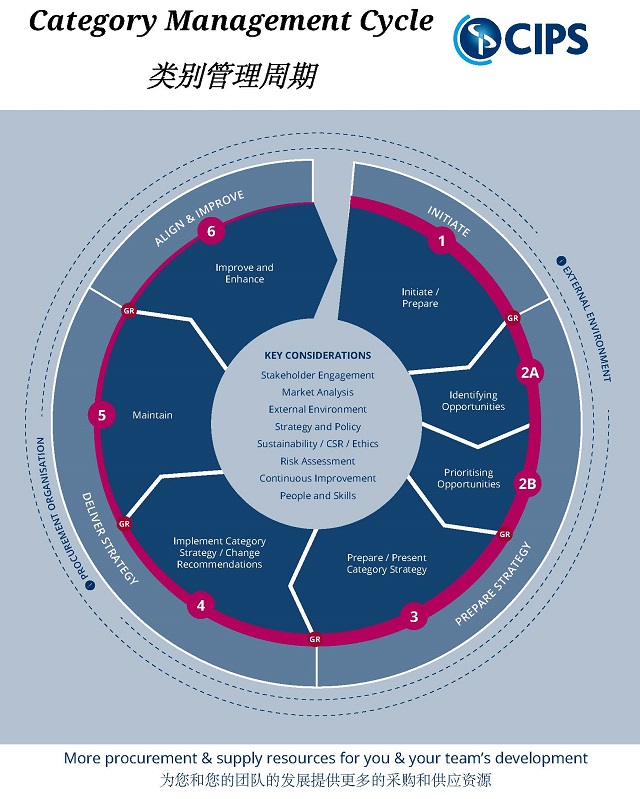- 【学习贴】品类管理周期的实际应用
- 发布时间:2023-07-04 17:09:46 阅读次数:203
Category management cycle in action
品类管理周期的实际应用

The category management cycle will help you to define an efficient category management process. This process is not set in stone and not all stages will always be relevant to all categories and all organisations. However, what this does do is provide you with a starting point and guidance to help devise an efficient category management process for procurement.
品类管理周期将帮助您定义高效的品类管理流程。这个过程并不是一成不变的,并非所有阶段都始终与所有类别和所有组织相关。然而,它的作用是为您提供一个起点和指导,帮助您设计高效的采购类别管理流程。
1. DEFINE CATEGORIES
1. 定义类别
Initiate / Prepare
启动/准备
Name the categories and decide what products or services procurement will manage within each.
命名类别并决定采购将在每个类别中管理哪些产品或服务。
Key Questions
关键问题
- What is the scope of the category?
- 该类别的范围是什么?
- Who are the key stakeholders?
- 谁是主要利益相关者?
- What key issues or problems need to be addressed, are you aware of the business objectives you need to consider?
- 需要解决哪些关键问题或问题,您是否了解需要考虑的业务目标?
- Do we have support for this work?
- 我们对这项工作有支持吗?
- Do we have the resources and skills to undertake the work?
- 我们有资源和技能来承担这项工作吗?
- Are we clear about the high-level benefits and risks?
- 我们清楚高层次的利益和风险吗?
2A. CREATE CATEGORY VISIONS
2A。创建品类愿景
Identifying Opportunities
识别机会
Establish a vision for the category which is aligned to the corporate vision.
为该类别建立与企业愿景一致的愿景。
Key Questions
关键问题
- Do we understand our business needs and issues (now and into the future as far as possible)?
- 我们是否了解我们的业务需求和问题(现在和未来尽可能)?
- Do we have a deep understanding of the external marketplace, its trends and dynamics, and an appreciation of our organisation’s position within this?
- 我们是否对外部市场、其趋势和动态有深入的了解,并了解我们组织在其中的地位?
- What opportunity for improvement can be gained by commercial and economic insight?
- 通过商业和经济洞察力可以获得哪些改进机会?
- Are the any quick-win opportunities that emerge through our immediate research and analysis? Can we implement these before developing a final strategy?
- 通过我们的直接研究和分析是否出现了任何快速获胜的机会?我们可以在制定最终策略之前实施这些吗?
2B. SET CATEGORY OBJECTIVES
2B。设定类别目标
Prioritising Opportunities
优先考虑机会
Decide and document what objectives need to be met to achieve each category's vision.
决定并记录需要实现哪些目标才能实现每个类别的愿景。
Key Questions
关键问题
- What are the changes and opportunities that will drive improved performance
- 哪些变化和机遇将推动绩效提高
- What risks need to be addressed?
- 需要应对哪些风险?
- What priorities make sense for the business?
- 哪些优先事项对企业有意义?
3. DEFINE CATEGORY STRATEGIES
3. 定义品类策略
Prepare/Present Category Strategy
准备/展示品类策略
Agree the strategies that need to be implemented to meet the categories' objectives.
商定为实现类别目标而需要实施的策略。
Key Questions
关键问题
- Is the strategy grounded and are the recommendations supported by the research and analysis?
- 该策略是否有依据?建议是否得到研究和分析的支持?
- What is the payback (benefit), how will it be measured and is it realistic and tangible?
- 回报(收益)是什么,如何衡量,是否现实且有形?
- Does the expected benefit stack up in relation to the anticipated risks and the resources required to deliver them?
- 预期收益是否与预期风险以及实现这些风险所需的资源相关?
- Does the strategy address the business issues and objectives identified at the outset?
- 该战略是否解决了最初确定的业务问题和目标?
4. IMPLEMENT CATEGORY STRATEGIES
4.实施品类策略
Implement Category Strategy / Change Recommendations
实施品类策略/变更建议
Roll out the strategies and achieve buy-in.
推出策略并获得认可。
Key Questions
关键问题
- Is the implementation and change programme being communicated effectively
- 实施和变革计划是否得到有效沟通
- Is implementation proceeding as outlined in the strategy?
- 实施是否按照战略中的概述进行?
- Are relationships and supporting structures in place?
- 关系和支持结构是否到位?
- Are performance measurement/reporting systems established?
- 是否建立绩效衡量/报告系统?
- Are benefits secured and captured?
- 利益是否得到保障和获取?
- Are transition risks being effectively managed?
- 转型风险是否得到有效管理?
- Are stakeholders satisfied?
- 利益相关者满意吗?
5. MEASURE & MONITOR STRATEGIES
5. 衡量和监控策略
Maintain
维持
Performance manage the progress of the strategies using KPIs or SLAs.
绩效使用 KPI 或 SLA 管理策略的进度。
Key Questions
关键问题
- Are we managing supplier and internal stakeholder relationships effectively
- 我们是否有效管理供应商和内部利益相关者的关系
- Have we identified and managed risks?
- 我们是否已识别并管理风险?
- Is the strategy delivering the expected benefits?
- 该策略能否带来预期收益?
- Is performance monitored
- 是否监控绩效
- Are issues effectively managed and resolved?
- 问题是否得到有效管理和解决?
6. REVIEW CATEGORIES
6. 评论类别
Improve and Enhance
改进和增强
Establish if the categories are still relevant? Do any amendments or additions need to be made?
确定类别是否仍然相关?是否需要作出任何修改或补充?
Key Questions
关键问题
-
Do we have mechanisms which identify and seek to deliver continuous improvements?
- 我们是否有识别并寻求持续改进的机制?
- Do we have the right internal and external behaviours and structures to generate and deliver change and innovation?
- 我们是否拥有正确的内部和外部行为和结构来产生和实现变革和创新?
- Are we aware of internal and external changes and routinely assess how they might present risk or opportunity?
- 我们是否意识到内部和外部的变化并定期评估它们可能如何带来风险或机遇?
- Is the category strategy still aligned to the needs and priorities of the organisation?
- 品类战略是否仍符合组织的需求和优先事项?







